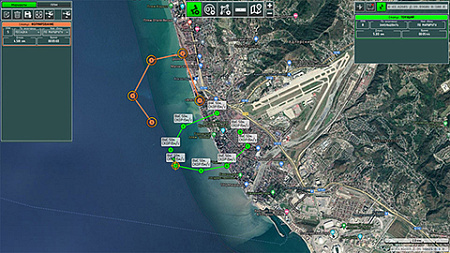Small-sized radars for aerial reconnaissance will be equipped with neural networks
In the recent past, the mass and size characteristics of radar stations (radars) allowed their placement only on manned aircraft and spacecraft. Today, they are being equipped not only with large drones (such as the Global Hawk), but also small tactical ScanEagle type (domestic analogues Merlin-21B, Orlan-10, Garnet-4) with a target load weight of up to 5 kg, and even RQ-11 Raven (analog of Grenades-2) with a mass of target load up to 1 kg.
It is small drones due to their low cost, according to the "Roadmap for the development of unmanned systems of the US Department of Defense for 2013-2038", will account for up to 70% of the total fleet of UAVs.
The reduction of the mass and size parameters of the radar is ensured by the use of a continuous frequency-modulated signal. The use of such a signal as a sounding signal is no alternative if we are talking about creating a high-resolution radar with a mass of several hundred grams to 1-2 kg.
A separate area of application of small-sized radars is their use as part of compact detection and anti-UAV systems. A common characteristic of radars with a continuous frequency-modulated signal, which distinguishes them favorably from pulsed systems, is a lower cost (due to the absence of pulsed microwave amplifiers in the design and simpler methods of demodulating broadband signals).
An experimental sample of a software and hardware complex for radar image processing (RLI) using neural network technologies has been developed at the Zhukovsky Air Force Academy together with JSC NPP Radar mms. It was presented at the recent Interpoltech-2023 exhibition in Moscow. The relevance of the development is due, firstly, to the lack of such tools in the tactical control link, and, secondly, to the need to automate the process of recognizing targets for timely opening of the movement of enemy equipment and speeding up the decision to defeat detected objects.
The complex is designed for aerial radar reconnaissance. It is a UAV with a radar placed on it. Images obtained in flight are received at the input of a convolutional neural network that recognizes objects and determines their coordinates on the ground.
To implement artificial intelligence (AI) technologies, it was necessary to create a bank of radar images from images of equipment samples from various angles obtained at different flight altitudes and inclined ranges to targets. To create the bank, radar images obtained as a result of radar survey of about 20 samples of military equipment using a multicopter radar were used.
The developers also resorted to image modeling. Using the electrodynamic modeling program CST Microwave Studio, the formation of reference radar of various samples of equipment was carried out. To train the neural network, standard variants of placing equipment on the ground in various combat formations were used – such as a column on the march, a sabotage and reconnaissance group, a motorized rifle company. This made it possible to increase the probability of recognition in conditions of insufficient resolution.
After collecting the training sample, the marking of equipment samples and standard variants of their placement was carried out. The marked-up data set was used in training the neural network. After training the network, a set of weighting coefficients is formed, which contains all the knowledge gained in the learning process. It is transferred to a computer that implements the work of a neural network.
The Russian and foreign analogues of intelligence means and complexes used in the tactical management were analyzed. The Russian Lancet is a reconnaissance and strike UAV; it is distinguished from its foreign counterparts by the use of AI in targeting and tracking targets. At the same time, all the presented analogues conduct reconnaissance only in the optical range.
The proposed hardware and software complex is currently the only promising radar reconnaissance complex in the tactical control unit that has no analogues. Its advantages include:
– complex processing of detection results by a convolutional neural network and automatic decision-making about the presence of a target;
– determination of coordinates of objects of military equipment with accuracy, ensuring the use of means of fire destruction;
– an effective combination of methods of full-scale radar survey and electrodynamic modeling of radar in order to form a training sample;
– the possibility of operational replenishment of the bank of radar images of objects in the process of conducting aerial reconnaissance.
The product was tested in a series of experiments, during which, in real flight conditions, options for using the prototype on various unmanned platforms were worked out. The product is being prepared for trial operation in the Armed Forces units and testing in the special operation zone.
In January 2023, an experiment was conducted in Rostov-on-Don to assess the feasibility of using a small-sized radar with a synthesized aperture of the "Quasar" antenna. All recommendations received have been implemented, all comments have been taken into account. Further work is planned to focus:
– on improving the quality of neural networks in terms of increasing the probability of detection and recognition of objects;
– expansion of the RLI bank;
– optimization of software to speed up the work of the complex;
– further testing in conditions close to real.
Valery Ageev
Valery Vladimirovich Ageev is a historian of aviation and cosmonautics, a journalist.


